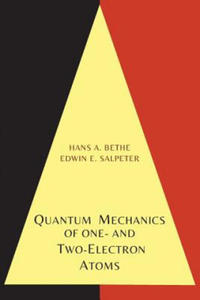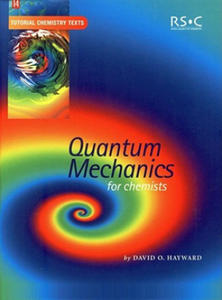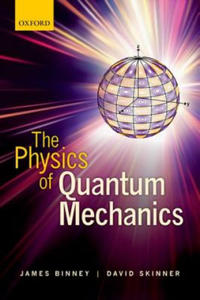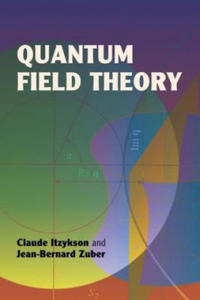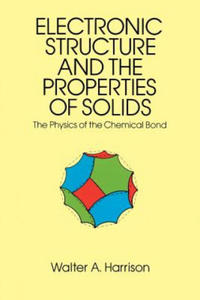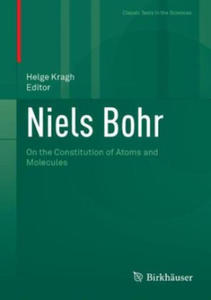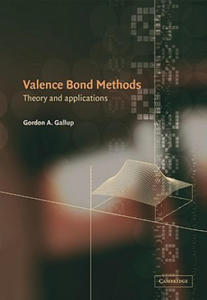libristo quantum mechanics of one and two electron atoms 4443607
- znaleziono 9 produktów w 1 sklepie
Quantum Mechanics of One- And Two-Electron Atoms Martino Fine Books
Książki / Literatura obcojęzyczna
2014 Reprint of 1957 Edition. Full facsimile of the original edition, not reproduced with Optical Recognition Software. This classic of modern physics includes a vast array of approximation methods, mathematical tricks, and physical pictures that are also
Sklep: Libristo.pl
Quantum Mechanics for Chemists Royal Society of Chemistry
Książki / Literatura obcojęzyczna
Quantum Mechanics for Chemists is designed to provide chemistry undergraduates with a basic understanding of the principles of quantum mechanics. The text assumes some knowledge of chemical bonding and a familiarity with the qualitative aspects of molecular orbitals in molecules such as butadiene and benzene. Thus it is intended to follow a basic course in organic and/or inorganic chemistry. The approach is rather different from that adopted in most books on quantum chemistry in that the Schr/dinger wave equation is introduced at a fairly late stage, after students have become familiar with the application of de Broglie-type wavefunctions to free particles and particles in a box. Likewise, the Hamiltonian operator and the concept of eigenfunctions and eigenvalues are not introduced until the last two chapters of the book, where approximate solutions to the wave equation for many-electron atoms and molecules are discussed. In this way, students receive a gradual introduction to the basic concepts of quantum mechanics.Ideal for the needs of undergraduate chemistry students, Tutorial Chemistry Texts is a major series consisting of short, single topic or modular texts concentrating on the fundamental areas of chemistry taught in undergraduate science courses. Each book provides a concise account of the basic principles underlying a given subject, embodying an independent-learning philosophy and including worked examples.
Sklep: Libristo.pl
Physics of Quantum Mechanics Oxford University Press
Książki / Literatura obcojęzyczna
The Physics of Quantum Mechanics aims to give students a good understanding of how quantum mechanics describes the material world. It shows that the theory follows naturally from the use of probability amplitudes to derive probabilities. It stresses that stationary states are unphysical mathematical abstractions that enable us to solve the theory's governing equation, the time-dependent Schroedinger equation. Every opportunity is taken to illustrate the emergence of the familiar classical, dynamical world through the quantum interference of stationary states. The text stresses the continuity between the quantum world and the classical world, which is merely an approximation to the quantum world. The connections between observables, operators and transformations are clearly explained and the standard commutation rules derived from the properties of spacetime. A chapter is devoted to entanglement, quantum computation, density operators and their role in thermodynamics, and the measurement problem.Scattering phenomena, including the origin of radioactivity, are handled early on in the accessible context of one dimension, and at the end of the book with some rigour in three dimensions. Hydrogen and helium are discussed in some detail and it is shown that quantum mechanics enables us to understand the structure of the periodic table without engaging with the complexities of many-electron atoms. Dirac notation is used from the outset and students are trained to move easily from one representation to another, choosing whichever representation is best suited to a particular problem. The mathematical prerequisites are no more than simple vector algebra, Taylor series expansion and the use of integrating factors to solve linear first order differential equations. Rigorous algebraic methods are preferred to the solution of partial differential equations.
Sklep: Libristo.pl
Quantum Field Theory Dover Publications Inc.
Książki / Literatura obcojęzyczna
PrefaceGeneral References1. Classical Theory 1.1 Principle of Least Action 1.1.1 Classical Motion 1.1.2 Electromagnetic Field as an Infinite Dynamical System 1.1.3 Electromagnetic Interaction of a Point Particle 1.2 Symmetries and Conservation Laws 1.2.1 Fundamental Invariants 1.2.2 Energy Momentum Tensor 1.2.3 Internal Symmetries 1.3 Propagation and Radiation 1.3.1 Green Functions 1.3.2 Radiation2. The Dirac Equation 2.1 Toward a Relativistic Wave Equation 2.1.1 Quantum Mechanics and Relativity 2.1.2 The Dirac Equation 2.1.3 Relativistic Covariance 2.2 Physical Content 2.2.1 Plane Wave Solutions and Projectors 2.2.2 Wave Packets 2.2.3 Electromagnetic Coupling 2.2.4 Foldy-Wouthuysen Transformation 2.3 Hydrogen-like Atoms 2.3.1 Nonrelativistic versus Relativistic Spectrum 2.3.2 Dirac Theory 2.4 Hole Theory and Charge Conjugation 2.4.1 Reinterpretation of Negative Energy Solutions 2.4.2 Charge Conjugation 2.4.3 Zero-Mass Particles 2.5 Dirac Propagator 2.5.1 Free Propagator 2.5.2 Propagation in an Arbitrary External Electromagnetic Field 2.5.3 Application to the Coulomb Scattering 2.5.4 Fock-Schwinger Proper Time Method3. Quantization--Free Fields 3.1 Canonical Quantization 3.1.1 General Formulation 3.1.2 Scalar Field 3.1.3 Charged Scalar Field 3.1.4 Time-Ordered Product 3.1.5 Thermodynamic Equilibrium 3.2 Quantized Radiation Field 3.2.1 Indefinite Metric 3.2.2 Propagator 3.2.3 Massive Vector Field 3.2.4 Vacuum Fluctuations 3.3 Dirac Field and Exclusion Principle 3.3.1 Anticommutators 3.3.2 Fock Space for Fermions 3.3.3 Relation between Spin and Statistics--Propagator 3.4 Discrete Symmetries 3.4.1 Parity 3.4.2 Charge Conjugation 3.4.3 Time Reversal 3.4.4 Summary4. Interaction with an External Field 4.1 Quantized Electromagnetic Field Interacting with a Classical Source 4.1.1 Emission Probabilities 4.1.2 Emitted Energy and the Infrared Catastrophe 4.1.3 Induced Absorption and Emission 4.1.4 S Matrix and Evolution Operator 4.2 Wick's Theorem 4.2.1 Bose Fields 4.2.2 Fermi Fields 4.2.3 General Case 4.3 Quantized Dirac Field Interacting with a Classical Potential 4.3.1 General Formalism 4.3.2 Emission Rate to Lowest Order 4.3.3 Pair Creation in a Constant Uniform Electric Field 4.3.4 The Euler-Heisenberg Effective Lagrangian5. Elementary Processes 5.1 S Matrix and Asymptotic Theory 5.1.1 Cross Sections 5.1.2 Asymptotic Theory 5.1.3 Reduction Formulas 5.1.4 Generating Functional 5.1.5 Connected Parts 5.1.6 Fermions 5.1.7 Photons 5.2 Applications 5.2.1 Compton Effect 5.2.2 Pair Annihilation 5.2.3 Positronium Lifetime 5.2.4 Bremsstrahlung 5.3 Unitarity and Causality 5.3.1 Unitarity and Partial Wave Decomposition 5.3.2 Causality and Analyticity 5.3.3 The Jost-Lehmann-Dyson Representation 5.3.4 Forward Dispersion Relations 5.3.5 Momentum Transfer Analyticity6. Perturbation Theory 6.1 Interaction Representation and Feynman Rules 6.1.1 Self-Interacting Scalar Field 6.1.2 Feynman Rules for Spinor Electrodynamics 6.1.3 Electron-Electron and Electron-Positron Scattering 6.1.4 Scalar Electrodynamics 6.2 Diagrammatics 6.2.1 Loopwise Expansion 6.2.2 Truncated and Proper Diagrams 6.2.3 Parametric Representation 6.2.4 Euclidean Green Functions 6.3 Analyticity Properties 6.3.1 Landau Equations 6.3.2 Real Singularities 6.3.3 Real Singularities of Simple Diagrams 6.3.4 Physical-Region Singularities. Cutkosky Rules7. Radiative Corrections 7.1 One-Loop Renormalization 7.1.1 Vacuum Polarization 7.1.2 Electron Propagator 7.1.3 Vertex Function 7.1.4 Summary 7.2 Radiative Corrections to the Interaction with an External Field 7.2.1 Effective Interaction and Anomalous Magnetic Moment 7.2.2 Radiative Corrections to Coulomb Scattering 7.2.3 Soft Bremsstrahlung 7.2.4 Finite Inclusive Cross Section 7.3 New Effects 7.3.1 Photon-Photon Scattering 7.3.2 Lamb Shift 7.3.3 Van der Waals Forces at Large Distances8. Renormalization 8.1 Regularization and Power Counting 8.1.1 Introduction 8.1.2 Regularization 8.1.3 Power Counting 8.1.4 Convergence Theorem 8.2 Renormalization 8.2.1 Normalization Conditions and Structure of the Counterterms 8.2.2 Bogoliubov's Recursion Formula 8.2.3 Zimmermann's Explicit Solution 8.2.4 Renormalization in Parametric Space 8.2.5 Finite Renormalizations 8.2.6 Composite Operators 8.3 Zero-Mass Limit, Asymptotic Behavior, and Weinberg's Theorem 8.3.1 Massless Theories 8.3.2 Ultraviolet Behavior and Weinberg's Theorem 8.4 The Case of Quantum Electrodynamics 8.4.1 Formal Derivation of the Ward-Takahashi Identities 8.4.2 Pauli-Villars Regularization to All Orders 8.4.3 Renormalization 8.4.4 Two-Loop Vacuum Polarization9. Functional Methods 9.1 Path Integrals 9.1.1 The Role of the Classical Action in Quantum Mechanics 9.1.2 Trajectories in the Bargmann-Fock Space 9.1.3 Fermion Systems 9.2 Relativistic Formulation 9.2.1 S Matrix and Green Functions in Terms of Path Integrals 9.2.2 Effective Action and Steepest-Descent Method 9.3 Constrained Systems 9.3.1 General Discussion 9.3.2 The Electromagnetic Field as an Example 9.4 Large Orders in Perturbation Theory 9.4.1 Introduction 9.4.2 Anharmonic Oscillator10. Integral Equations and Bound-State Problems 10.1 The Dyson-Schwinger Equations 10.1.1 Field Equations 10.1.2 Renormalization 10.2 Relativistic Bound States 10.2.1 Homogeneous Bethe-Salpeter Equation 10.2.2 The Wick Rotation 10.2.3 Scalar Massless Exchange in the Ladder Approximation&n 12.3 The Effective Action at the One-Loop Order 12.3.1 General Form 12.3.2 Two-Point Function 12.3.3 Other Functions 12.3.4 One-Loop Renormalization 12.4 Renormalization 12.4.1 Slavnov-Taylor Identities 12.4.2 Identities for Proper Functions 12.4.3 Recursive Construction of the Counterterms 12.4.4 Gauge Dependence of Green Functions 12.4.5 Anomalies 12.5 Massive Gauge Fields 12.5.1 Historical Background 12.5.2 Massive Gauge Theory 12.5.3 Spontaneous Symmetry Breaking 12.5.4 Renormalization of Spontaneously Broken Gauge 12.5.5 Gauge Independence and Unitarity of the S Matrix 12.6 The Weinberg-Salam Model 12.6.1 The Model for Leptons 12.6.2 Electron-Neutrino Cross Sections 12.6.3 Higher-Order Corrections 12.6.4 Incorporation of Hadrons13. Asymptotic Behavior 13.1 Effective Charge in Electrodynamics 13.1.1 The Gell-Mann and Low Function 13.1.2 The Callan-Symanzik Equation 13.2 Broken Scale Invariance 13.2.1 Scale and Conformal Invariance 13.2.2 Modified Ward Identities 13.2.3 Callan-Symanzik Coefficients to Lowest Order 13.3 Scale Invariance Recovered 13.3.1 Coupling Constant Flow 13.3.2 Asymptotic Freedom 13.3.3 Mass Corrections 13.4 Deep Inelastic Lepton-Hadron Scattering and Electron-Positron Annihilation into Hadrons 13.4.1 Electroproduction 13.4.2 Light-Cone Dynamics 13.4.3 Electron-Positron Annihilation 13.5 Operator Product Expansions 13.5.1 Short-Distance Expansion 13.5.2 Dominant and Subdominant Operators, Operator Mixing, and Conservation Laws 13.5.3 Light-Cone ExpansionAppendixA-1 MetricA-2 Dirac Matrices and SpinorsA-3 Normalization of States, S Matrix, Unitarity, and Cross SectionsA-4 Feynman RulesIndex
Sklep: Libristo.pl
Quantum Orion Publishing Co
Książki / Literatura obcojęzyczna
Quantum mechanics underpins modern science and provides us with a blueprint for reality itself. And yet it has been said that if you're not shocked by it, you don't understand it. But is quantum physics really so unknowable? Is reality really so strange? And just how can cats be half-alive and half-dead at the same time? Our journey into the quantum begins with nature's own conjuring trick, in which we discover that atoms -- contrary to the rules of everyday experience -- can exist in two locations at once. To understand this we travel back to the dawn of the twentieth century and witness the birth of quantum theory, which over the next one hundred years was to overthrow so many of our deeply held notions about the nature of our universe. Scientists and philosophers have been left grappling with its implications every since.
Sklep: Libristo.pl
Electronic Structures and the Properties of Solids Dover Publications Inc.
Książki / Literatura obcojęzyczna
Part I. Electron states 1. The quantum-mechanical basis A. Quantum mechanics B. Electronic structure of atoms C. Electronic structure of small molecules D. The simple polar bond E. Diatomic molecules 2. Electronic structure of solids A. Energy bands B. Electron dynamics C. Characteristic solid types D. Solid state matrix elements E. Calculation of spectraPart II. Covalent solids 3. Electronic structure of simple tetrahedral solids A. Crystal structures B. Bond orbitals C. The LCAO bands D. The bond orbital approximation and extended bond orbitals E. Metallicity F. Planar and filamentary structures 4. Optical spectra A. Dielectric susceptibility B. Optical properties and oscillator strengths C. Features of the absorption spectrum D. chi subscript 1 and the dielectric constant 5. Other dielectric properties A. Bond dipoles and higher-order susceptibilities B. Effective atomic charge C. Dielectric screening D. Ternary compounds E. Magnetic susceptibility 6. The energy bands A. Accurate band structures B. LCAO Interpretation of the bands C. The conduction bands D. Effective masses E. Impurity states and excitons 7. The total energy A. The overlap interaction B. Bond length, cohesive energy, and the bulk modulus C. Cohesion in polar covalent solids 8. Elasticity A. Total energy calculations B. Rigid hybrids C. Rehybridization D. The Valence force field E. Internal displacements, and prediction of c subscript 44 9. Lattice Vibrations A. The Vibration spectrum B. Long range forces C. Phonons and the specific heat D. The transverse charge E. Piezoelectricity F. The Electron-phonon interaction 10. Surfaces and defects A. Surface energy and crystal shapes B. Surface reconstruction C. The elimination of surface states, and Fermi level pinning D. Adsorption of atoms and the 7 x 7 reconstruction pattern E. Defects and amorphous semiconductors F. Photothresholds and heterojunctions 11. Mixed tetrahedral solids A. Tetrahedral complexes B. The crystal structure and the simple molecular lattice C. The bonding unit D. Bands and electronic spectra E. Mechanical properties F. Vibrational spectra G. Coupling of vibrations to the infraredPart III Closed-shell systems 12. Inert-gas solids A. Interatomic interactions B. Electronic properties 13. Ionic compounds A. The crystal structure B. Electrostatic energy and the Madelung potential C. Ion-Ion Interactions D. Cohesion and Mechanical Properties E. Structure Determination and Ionic Radii 14. Dielectric properties of ionic crystals A. Electronic structure and spectra B. Dielectric susceptibility C. Effective charges and ion softening D. Surfaces and molten ionic compoundsPart IV Open-shell systems 15. Simple metals A. History of the theory B. The Free-electron theory of metals C. Electrostatic energy D. The empty-core pseudopotential E. Free-electron energy F. Density, bulk modulus, and cohesion 16. Electronic structure of metals A. Pseudopotential perturbation theory B. Pseudopotentials in the perfect lattice C. Electron diffraction by pseudopotentials D. Nearly-free-electron bands and Fermi surfaces E. Scattering by defects F. Screening 17. Mechanical properties of metals A. The band-structure energy B. The effective interaction between ions, and higher-order terms C. The phonon spectrum D. The electron-phonon interaction and the electron-phonon coupling constant E. Surfaces and liquids 18. Pseudopotential theory of covalent bonding A. The prediction of interatomic matrix elements B. The Jones zone gap C. Covalent and polar contributions D. Susceptibility E. Bonding properties F. Ionic bonding G. Interfaces and Heterojunctions 19. Transition-metal compounds A. d States in solids B. Monoxides: Miltiplet d States C. Perovskite structures; d Bands D. Other compounds E. The Perovskite ghost F. The chemical grip G. The electrostatic stability of Perovskites H. The electron-phonon interaction 20 Transition metals A. The bands B. The electronic properties and density of states C. Cohesion, bond length, and compressibility D. Muffin-Tin Orbitals and the Atomic Sphere Approximation E. d Resonances and transition-metal pseudopotentials F. Local moments and magnetismAppendix A. The One-electron approximationAppendix B. Nonorthogonality of basis statesAppendix C. The overlap interactionAppendix D. Quantum-mechanical formulation of pseudopotentialsAppendix E. Orbital corrections Solid state table of the elements Bibliography and author index Subject index
Sklep: Libristo.pl
Solid State Theory Dover Publications Inc.
Książki / Literatura obcojęzyczna
PrefaceI SOLID TYPES AND SYMMETRY 1 Crystal Structures 2 Symmetry of Crystals 3 Physical Tensors 4 Symmetry Arguments and Group Theory 4.1 Groups 4.2 Representations 4.3 Equivalent representations 4.4 Symmetry degeneracies 4.5 Orthogonality relation 4.6 Characters 4.7 Reduction of representations 5 Applications of Group Theory 5.1 Lowering of symmetry 5.2 Vibrational states 5.3 The translation group-one dimensionII ELECTRON STATES 1 The Structure of the Bands 2 Electron Dynamics 3 The Self-Consistent-Field Approximation 3.1 The Hartree approximation 3.2 The Hartree-Fock approximation 3.3 Free-electron exchange 3.4 Koopman's theorem 3.5 The crystal potential 4 Energy-Band Calculations 4.1 The cellular method 4.2 The plane-wave method 4.3 The orthogonalized-plane-wave method 4.4 The augmented-plane-wave method 4.5 The symmetry of the energy bands 4.6 Calculated energy bands 5 Simple Metals and Pseudopotential Theory 5.1 The pseudopotential 5.2 The model-potential method 5.3 Free-electron bands 5.4 The diffraction approximation 5.5 One-OPW Fermi surfaces 5.6 Experimental studies of Fermi surfaces 5.7 Multile-OPW Fermi surfaces 6 Semiconductor and Semimetal Bands 6.1 k
Sklep: Libristo.pl
Niels Bohr Springer Nature Switzerland AG
Książki / Literatura obcojęzyczna
Niels Bohr's atomic theory of 1913 is one of the absolute highlights in the history of modern science. It was only with this work that physicists realized that quantum theory is an essential ingredient in atomic physics, and it was also only with this work that Rutherford's nuclear model dating from 1911 was transformed into a proper theory of atomic structure. In a longer perspective, Bohr's quantum atom of 1913 gave rise to the later Heisenberg-Schrödinger quantum mechanics and all its marvellous consequences. This book is a detailed account of the origin of the Bohr atom centred around his original scientific articles of 1913 which are here reproduced and provided with the necessary historical background. In addition to the so-called trilogy - the three papers published in Philosophical Magazine - also two other and less well-known yet important papers are included.The present work starts with a condensed biographical account of Bohr's life and scientific career, from his birth in Copenhagen in 1885 to his death in the same city 77 years later. It then proceeds with a chapter outlining earlier ideas of atomic structure and tracing Bohr's route from his doctoral dissertation in 1911 over his stays in Cambridge and Manchester to the submission in April 1913 of the first part of the trilogy. The reproduction of Bohr's five articles is followed by notes and comments directly related to the texts, with the aim of clarifying some of the textual passages and to explicate names and subjects that may not be clear or well known. The reception of Bohr's radically new theory by contemporary physicists and chemists is discussed in a final chapter, which deals with the immediate reactions to Bohr's theory 1913-1915 mostly among British, German and American scientists.Historians of science have long been occupied with Bohr's atomic theory, which was the subject of careful studies in connection with its centenary in 2013. The present work offers an extensive source-based account of the original theory aimed at a non-specialist audience with an interest in the history of physics and the origin of the quantum world. In 1922 Bohr was awarded the Nobel Prize for his theory. The coming centenary will undoubtedly cause an increased interest in how he arrived at his revolutionary picture of the constitution of atoms and molecules.
Sklep: Libristo.pl
Valence Bond Methods Cambridge University Press
Książki / Literatura obcojęzyczna
Valence bond theory is one of two commonly used methods in molecular quantum mechanics, the other is molecular orbital theory. This book focuses on the first of these methods, ab initio valence bond theory. The book is split into two parts. Part I gives simple examples of two-electron calculations and the necessary theory to extend these to larger systems. Part II gives a set of case studies of related molecule sets designed to show the nature of the valence bond description of molecular structure. It also highlights the stability of this description to varying basis sets. There are references to the CRUNCH computer program for molecular structure calculations which is currently available in the public domain. The book will be of primary interest to researchers and students working on electronic theory and computation in chemistry and chemical physics.
Sklep: Libristo.pl
Sklepy zlokalizowane w miastach: Warszawa, Kraków, Łódź, Wrocław, Poznań, Gdańsk, Szczecin, Bydgoszcz, Lublin, Katowice
Szukaj w sklepach lub całym serwisie
1. Sklepy z libristo pl quantum mechanics of one and two electron atoms 4443607
2. Szukaj na wszystkich stronach serwisu
t1=0.03, t2=0, t3=0, t4=0, t=0.03

